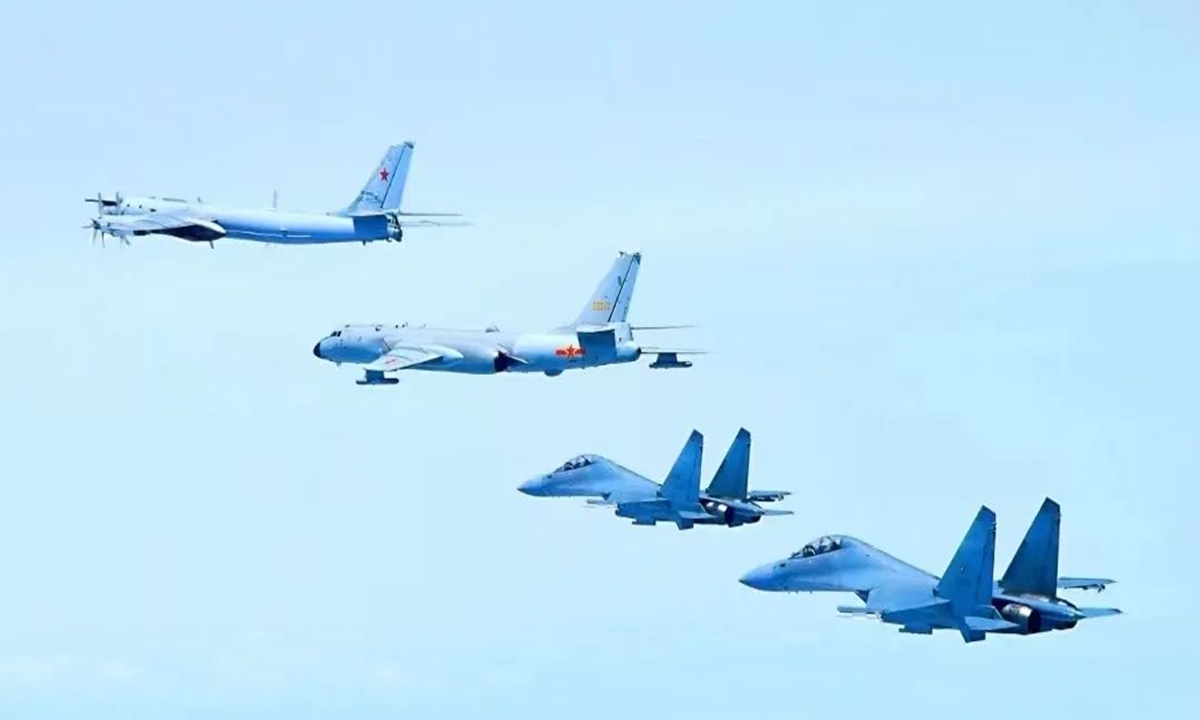
Two Chinese J-16 fighter jets conduct an escort mission for a Chinese H-6K bomber and a Russian Tu-95MS bomber during a regular China-Russia joint strategic patrol above the Sea of Japan, the East China Sea and the West Pacific on May 24, 2022. Photo: Screenshot from China Central Television
The militaries of China and Russia on Tuesday carried out a joint aerial strategic patrol in the Asia-Pacific region, a move that experts said is conducive to peace and stability, offsetting the impact of consecutive US-led provocations in the region.
Based on an annual cooperation schedule between the Chinese and Russian militaries, the two sides conducted the sixth joint aerial strategic patrol over the Sea of Japan and the East China Sea on Tuesday, China's Ministry of National Defense announced in a press release on the day.
South Korea said that four Chinese and four Russian military planes entered its air defense identification zone on Tuesday without violating the country's air space, the Yonhap News Agency reported.
Japan's Ministry of Defense Joint Staff said in a statement on Tuesday that two Chinese H-6K bombers and two Russian Tu-95 bombers, escorted by two unidentified Chinese fighter jets, flew together over the East China Sea and the Sea of Japan on the day.
China and Russia have been regularly holding joint aerial strategic patrols since 2019.
The latest China-Russia joint patrol came amid rising tensions in the Asia-Pacific region, when no meeting took place between the Chinese and US defense chiefs at the Shangri-La Dialogue in Singapore last weekend, due to the US' lack of sincerity to communicate.
The US has made provocations including sending
a spy plane to the South China Sea to peek on a training session of China's aircraft carrier Shandong on May 26, and partnered with Canada in
a warship transit in the Taiwan Straits on Saturday. Both moves saw resolute interception maneuvers by the Chinese People's Liberation Army (PLA).
NATO's potential expansion into the Asia-Pacific region has also caused wide concerns after Japan announced last month a plan to open NATO's first liaison office in Asia, even though NATO's eastward expansion had already led to the Ukraine crisis.
The China-Russia joint strategic patrol displayed the two countries' capabilities in the safeguarding of peace and stability in the West Pacific at a time when continued provocations led by the US have severely disrupted peace and stability in the region, Wei Dongxu, a Beijing-based military expert, told the Global Times on Tuesday.
It serves as a powerful counterbalance to the US' hegemonic actions, Wei said.
China showed transparency and confidence by making the announcement earlier than all other parties, which is also a responsible move to prevent misjudgment, Zhang Xuefeng, another Chinese military expert, told the Global Times on Tuesday.
The timing of the joint patrol is sensitive following the Shangri-La Dialogue and the US hyping of PLA vessel and aircraft interceptions, Zhang said.
It showed just how firm the China-Russia military cooperation is, the expert said.
Observers said that in addition to aerial maneuvers, the Chinese and Russian navies also operated in the same region on the same day, indicating a certain level of sea and air integration as part of the joint strategic patrol and a further deepening of China-Russia military cooperation.
Japan's Maritime Self-Defense Force spotted a PLA Navy flotilla consisting of the Type 055 large destroyer
Anshan and the Type 054A frigate
Linyi when they sailed from the East China Sea through the Tsushima Strait into the Sea of Japan from Saturday to Monday, Japan's Ministry of Defense Joint Staff said in a press release on Monday.
Also, the Type 052D destroyer
Xiamen and the Type 054A frigate
Yangzhou of the PLA Navy sailed from the East China Sea through the Miyako Strait into the West Pacific on Tuesday, according to a separate press release from Japan's Ministry of Defense Joint Staff on Tuesday.
The Russian Pacific Fleet launched an exercise in the Sea of Japan and the Sea of Okhotsk on Monday, sending over 60 warships and 35 aircraft, according to a statement released by Russia's Defense Ministry on the day.
The movements at sea could be interrelated with the aerial patrol, as the warships could coordinate with the warplanes and provide intelligence with their long-range radar systems, Wei said.




